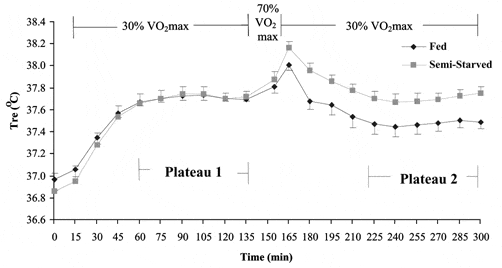Periods of fasting (Macdonald et al. 1984) can alter deep body temperature at rest. This study examined the hypothesis that semi-starvation influences thermoregulation during prolonged low-intensity exercise.
Following ethical approval and informed consent, seven healthy male subjects undertook a crossover design, in which they undertook two 5 h walks at 30 % ΩO2,max in an environmental chamber at 18 °C and 64 % relative humidity. During each walk, subjects completed a 10 min exercise period at 70 % ΩO2,max after 145 min. Before one walk, subjects consumed a standardised diet (2400 kcal) over the preceding 24 h period, with a breakfast (400 kcal) 2 h before walking (fed condition, FC). Before the other walk they ingested a reduced caloric intake of 200 g of barley sugars (800 kcal) over the preceding 60 h (semi-starved condition, SSC); at least 7 days elapsed between conditions. Skin temperature (Tsk) and heat flux from four sites (calf, triceps, chest, thigh), rectal temperature (Tre) and heart rate were measured each minute. Oxygen uptake was recorded every 15 min and capillary blood glucose every hour. Sweat production was estimated from nude body mass, accounting for respiratory and substrate loss. Urinary osmolality was measured pre- and post-exercise. Data were analysed using an ANOVA and a Wilcoxon test.
The initial temperature at which Tre stabilised following commencement of exercise did not differ between conditions (Fig. 1, Plateau 1). The increase in exercise intensity resulted in an increase in Tre in both conditions. However, on return to low intensity exercise, Tre remained higher in the SSC compared with the FC (P < 0.01) (Fig. 1, Plateau 2). Plateau 1 and Plateau 2 did not differ in the SSC, thus the difference between conditions was caused by Tre stabilising at a lower temperature following intense exercise in the FC (P < 0.01). Heat production, heat flux and mean skin temperature were similar in both conditions and are unlikely to explain the differences seen in Tre. The urinary osmolality results for the two conditions suggest that dehydration was not responsible for the higher Tre in the SSC (pre: FC 340 ± 222; SSC 300 ± 190; post: FC 438 ± 311; SSC 503 ± 265 mosmol kg-1). Over the exercise period, sweat production was significantly reduced in the SSC (791 ± 576 g) compared with FC (1052 ± 241 g) (P < 0.05).
It is concluded that during prolonged low-intensity exercise a brief period of high-intensity exercise reduces the level at which body temperature is regulated in the fed individual. This reduction is not seen with semi-starvation, possibly due to reduced sweating in this condition.

